This and that-Between workshops!
It’s been 2 weeks and 4 days since I last posted.
I have finished one of the 3 pieces and about a third and closing in on a half of the second piece of the three. This one is entitled Line. Some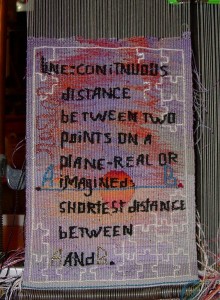 of the pressure is off for now. I have at least one piece to enter in a particular show that I wish to enter, whether I get in or not is another matter and of little importance. The deadline is everything. Completing the pieces are all that matter. The piece is finished for the most part. To me important thing is that I like the piece with it’s slight dose of humour and it’s slight bit of hidden sarcasm. I think it tells its story.
of the pressure is off for now. I have at least one piece to enter in a particular show that I wish to enter, whether I get in or not is another matter and of little importance. The deadline is everything. Completing the pieces are all that matter. The piece is finished for the most part. To me important thing is that I like the piece with it’s slight dose of humour and it’s slight bit of hidden sarcasm. I think it tells its story.
I think/know that I am becoming impossibly jaded towards exhibiting my work. I realize I am questioning why I enter shows. One exhibit I have entered and exhibited in every 2 years since the early 90’s I have been in 14 times. At this point I exhibit and show because it looks good on my teaching resume. Not because I am particularly tied or emotionally tied to a venue or exhibit, or the creation of the exhibit. It has become too much of a game-a game of chances-not so much of skill or being vetted for skillfully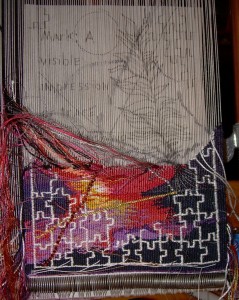 designing and constructing a piece, but a partcular juror’s whim. The same old-same old.
designing and constructing a piece, but a partcular juror’s whim. The same old-same old.
My greatest joy of a day is weaving at least 6 hours a day and
watching the fell line build until it’s over-in ever growing crescendo…Then, done, finito, a mental le petit mort, finished,etc. I have trouble maintaining an interest in the piece once it’s off the loom. It becomes an afterthought, curiosity, a type of momento morrii or a vanitas. or a reminder to weave well and learn from the past weavings.
“in all thy works be mindful of thy last end and thou wilt never sin.”Ecclesiastics 7:40(Vulgate)My  Grandmother made me memorize this verse when I was about 5 years old. Not sure she knew I would apply it to my weaving. It seems to have stuck for close to 60 years.
Grandmother made me memorize this verse when I was about 5 years old. Not sure she knew I would apply it to my weaving. It seems to have stuck for close to 60 years.
Photos taken of a Smokey Columbia river from a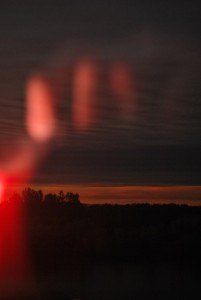 moving train while on my way home from teaching in the tri-cities in Washington. The ghostly fingers are the reflection in the window of my fingers holding the camera.
moving train while on my way home from teaching in the tri-cities in Washington. The ghostly fingers are the reflection in the window of my fingers holding the camera.
It’s always just a tad bothersome when entering shows that I can submit 3 pieces and they will choose one of the 3. It’s also a bit bothersome that this particular exhibit has a theme. When the other shows orchestrated by this particular organization don’t. Why limit the pieces or have a theme? It’s not as if one piece takes up way too much space say such as a 5 foot by 4 foot large format tapestry. Perhaps, it is thought that small format weavers can only design with a theme for an exhibit and I haven’t seen the limitation of 1 out of 3 in other exhibits. I think that themes and limits hide the diversity and possibilities of what small format tapestries can and are capable of achievi
possibilities of what small format tapestries can and are capable of achievi ng by limiting expectations.
ng by limiting expectations.
Above Naked Ladies from Yachats, OR beginning to bud and bloom. Seems appropriate for a discussion of the above.
Enuff! It is what it is!
I am beginning something I rarely do.
I journal all the time, but have never really done it as a theme journal for a short period of time. Marcia Keefer has been creating small portable journals and binding them. This particular one is a resist dyed felt backed with leather with an anemone spine closure and beaded. It is filled with an incredibly sensuous paper that should be nice to write on. Marcia took a sewing thread class from me many many years ago. The out 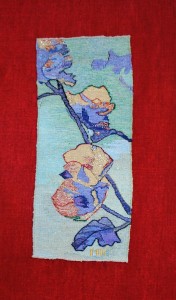 come was one of my favourite small format/small scale pieces. I have acquired a small journal from her that is quite beautiful.
come was one of my favourite small format/small scale pieces. I have acquired a small journal from her that is quite beautiful. 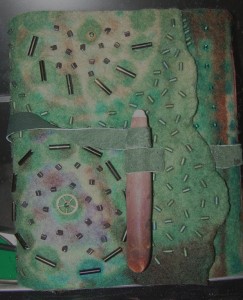
So, I have decided to use it to document a month of an itinerant teacher. I am not a weaver of journals. I haven’t figured out why people do them, but I do enjoy the tapestry journals that other weavers-Such as Tommye Scanlin, Jan Austin to name a few of my favourites. So my homage to tapestry journals will be recording a month 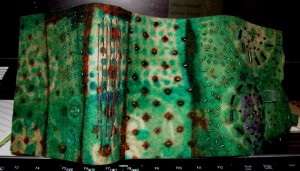 and documenting intense travel, teaching tapestry, intensive weaving to create a journal of my experiences in a beautifully made journal.
and documenting intense travel, teaching tapestry, intensive weaving to create a journal of my experiences in a beautifully made journal.
When I teach in the Tri-Cities I always come away knowing that I have taught perhaps a new skill or two a group of women who are a bunch artistically well rounded fabulous artist-basket weavers, book arts, dyers, weavers, etc. Who make all arts a part of their everyday lives. More on these guys later including pictures-next time I write. They are an intriguing group of women artist.
Floating to the surface in this class was a wonderful Ukrainian Soumack rug and 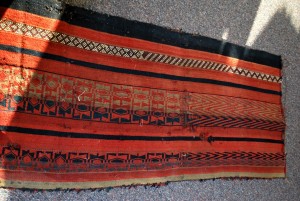 a Syrian rug.
a Syrian rug.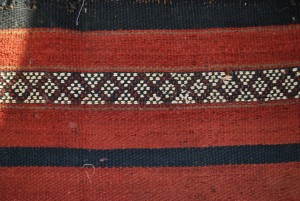

Syrian Rug
with details
Details of soumack rug that was too big to Photograph all of-so just a couple of details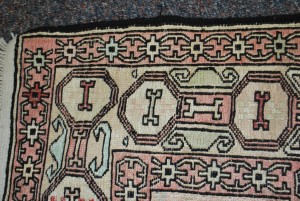
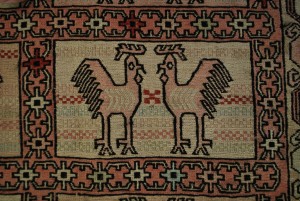
A little bit of tapestry technique as promised.
Hills and valleys, and ridding ones tapestry of vicious teeth. Just realized how apt this subject is for the month that ends with Halloween-LOL.
Caveat! These comments are made weaving from the front, but can be easily be reversed and used weaving from the back.
So what are these hills and valleys and vicious teeth?
In its simplest form- Either a hill or valley is created every time one does a half pass along the fell line. The hill is created when the weft crosses in front of a warp. A valley is created when the weft crosses in back of the warp. 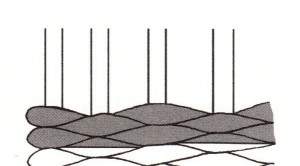 Teeth or toothing is another word or descriptor used because in a comic sense the fell line looks like a series of small teeth sticking up. In this diagram the turn on the left is a hill thread. second thread is a valley and the third thread is a hill and the fourth a valley.
Teeth or toothing is another word or descriptor used because in a comic sense the fell line looks like a series of small teeth sticking up. In this diagram the turn on the left is a hill thread. second thread is a valley and the third thread is a hill and the fourth a valley.
It would be easy to say no big deal. Why not just leave well enough alone? It’s the nature of tapestry weaving, but that’s not necessarily so. It’s easy to control and get rid of.
These hills and valleys, and toothing are ignored in whole cultures of tapestry weaving. The argument for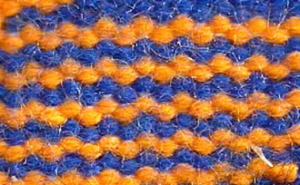 leaving it or ignoring hills and valleys is that the mind of the viewer repeats the answer(straight line) because they have not been able to forget a past question and move on to the current subject(non wavy line). The mind has seen straight smooth lines therefore it is a straight smooth line. Whether it is or not. The mind often sees what it wishes to see. The further one stands back from a tapestry the less one sees the wavy or toothed line. So why bother? The psyche term for the phenomena is perseveration.
leaving it or ignoring hills and valleys is that the mind of the viewer repeats the answer(straight line) because they have not been able to forget a past question and move on to the current subject(non wavy line). The mind has seen straight smooth lines therefore it is a straight smooth line. Whether it is or not. The mind often sees what it wishes to see. The further one stands back from a tapestry the less one sees the wavy or toothed line. So why bother? The psyche term for the phenomena is perseveration.
The problem is-sorry to say- that when weaving small format and small scale people stand very close to a tapestry and examine it in a different way then one would a large/scale format weaving. They stand so close that things such as optical blending and perseveration just don’t happen. Small things become harder to ignore and more obvious. So if you need to see a straight line and not a wavy line it’s annoying and can possibly detract from the design elements. The bottom of triangular shapes, squares, circles don’t look smooth. They look toothed and wavy, because they are. 
lines with split weft-ignore center panel floating bars-panel on right
So- there are two or three ways to deal with actually 3-4 if ignore is counted as a solution.
1. Ignore it. Stand back and let it optically blend into a straight line. Less work-just let your eye ignore the small details. Great on large format not so much on small/scale small format tapestry. One needs to stand too close to see detail or choose to stand further back and maybe the very toothed lines will perseverate before you can’t se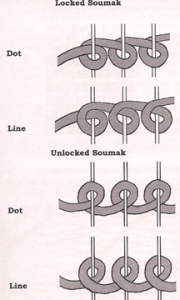 e detail. A laissez faire solution.
e detail. A laissez faire solution.
2.Use soumack for the lines. Soumack lines can pretty much smooth out any area-fell lines, sides of geometric objects etc. Problem it is slower then weaving over and under. Some consider it not be a weaverly solution, but it does work in tapestry.
It’s been used at Gobelin for centuries and is called arrondiment.
3. Split the weft. My favourite solution! Splitting the weft fills in have the valley of the base colour and the base colour of the the next half pass. 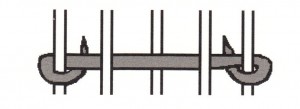
Step A- Half of the weft bundle
Step B-half of the next weft bundle placed in the same shed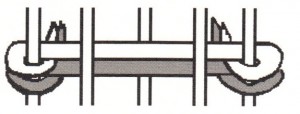
Step C-close shed and weave with new colour
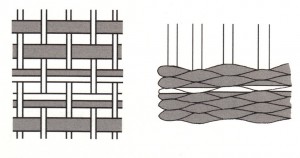
Split weft variation for very fine smooth lines.
Enough for now. I have bags to repack and details to check.
Another caveat illustrations are by Pat Spark taken from my book Tapestry 101 and are copy right. All photos on this page were taken by me and are also copyrighted images and may not be used without the express permission of the author and illustrator.  Day break on a smoky Columbia river! Next Stop Colorado Springs, Colorado!
Day break on a smoky Columbia river! Next Stop Colorado Springs, Colorado!
kathe